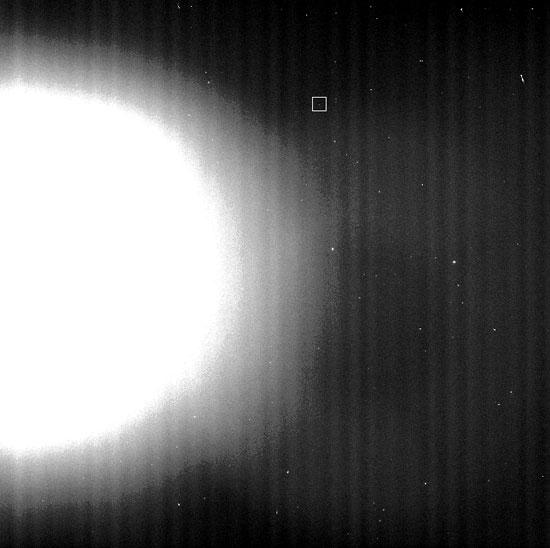Cassini Uncovers New Moon

| Credit | NASA/JPL/Space Science Institute |
|---|---|
| PIA Number | PIA06106 |
| Language |
|
Cassini Uncovers New Moons
August 16, 2004
Cassini continues to uncover new wonders within the Saturn system with its discovery of two new moons orbiting between Mimas and Enceladus.
This movie shows the tiny "worldlet," temporarily dubbed S/2004 S2, as it makes its way around the planet. A white box frames the moon's location in the image. The image is part of a sequence specifically designed to search for new moons in the inner saturnian system. The image has not been cleaned of imaging artifacts but has been greatly enhanced in contrast to increase visibility. Consequently, the background scattered light from the nearby rings, as well as many cosmic ray hits and noise patterns, are clearly apparent.
The size of S/2004 S2 is estimated to be 4 kilometers (about 2.5 miles) across. Because the moon is small and not resolved it appears as a faint point of light just barely visible above the background.
The image was taken on June 1, 2004, at a distance of 16.5 million kilometers (10.3 million miles) from Saturn. The image scale is approximately 100 kilometers (62 miles) per pixel. The view was taken looking upward from Cassini's southern vantage point beneath the ring plane.
The movie consists of two segments: The first covers about 10 degrees of the moon's orbit around Saturn on the left side of the planet, followed by an 80-degree gap, and then another revolution of approximately 30 degrees on the right side. The movie is made up of 28 frames acquired over a period of nine-and-one-quarter hours. The overexposed object seen orbiting Saturn is Enceladus.
The moon appears to circle the planet at roughly 211,000 kilometers (131,000 miles). More precise orbit sizes and shapes, as well as any tilt the orbits might have relative to Saturn's ring plane, will require the acquisition of future imaging observations by the Cassini cameras.
The Cassini-Huygens mission is a cooperative project of NASA, the European Space Agency and the Italian Space Agency. The Jet Propulsion Laboratory, a division of the California Institute of Technology in Pasadena, manages the Cassini-Huygens mission for NASA's Science Mission Directorate, Washington, D.C. The Cassini orbiter and its two onboard cameras were designed, developed and assembled at JPL. The imaging team is based at the Space Science Institute, Boulder, Colo.
For more information about the Cassini-Huygens mission, visit http://saturn.jpl.nasa.gov and the Cassini imaging team home page, http://ciclops.org .
